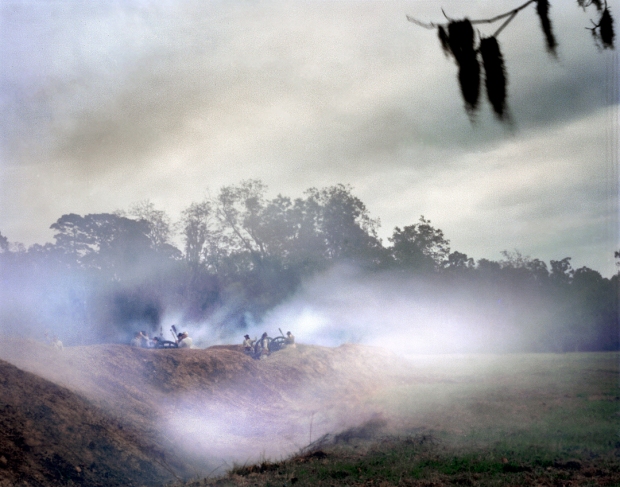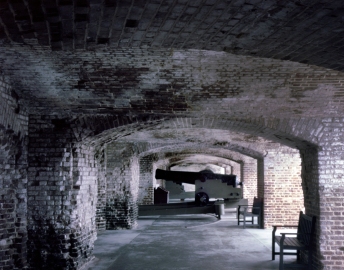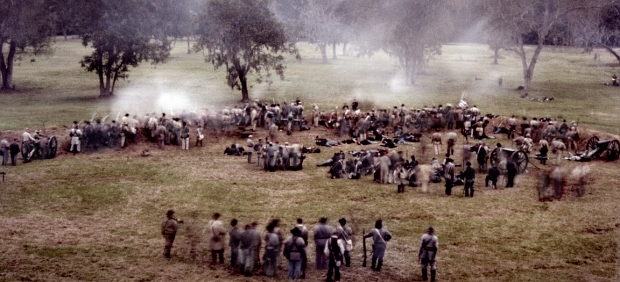Charleston, Fort Sumter and Battery Wagner
Boone Plantation, Mount Pleasant, SC
As you enter the historic Boone Hall Plantation in South Carolina’s low country you are greeted by a mile-long stand of enormous Evergreen Oak trees draped in spanish moss. These trees were planted here in 1743 by Captain Thomas Boone, son to Major John Boone, who was granted this rich piece of land by King Charles of England in 1681.
This “Avenue of Oaks” that line the main drive to the plantation is an iconic vision of the old Antebellum South. The wide grand lane leads to a gate and a large manor house…the soundtrack to Gone With the Wind instinctively begins in your head.
Also, symmetrically lined up along the drive, you can’t help but notice a neat set of small brick buildings. These modest dwellings, we are told, once housed the Plantations’ manual laborers…..African slaves.
The institution of slavery and its’ relation to the American Civil War is unavoidable here in South Carolina. At its heart, just across the river from Boone Plantation, the City of Charleston and Fort Sumter site of the first shots of the Civil War – but more notably nearby Sullivan Island which was the quarantine center and entry point for more then half of all people of african descent forcibly brought to America between the 17th and 19th centuries.
The legacy of slavery and the Civil War is made all the more apropos here by the fact that Boone Plantation in 2013 became the site of the 150th anniversary reenactment of the Battle of Fort Wagner. The Battle of Fort Wagner occurred on neighboring Morris Island in July 1863 and is famous for the assault on the Confederate held fort by the Union’s all-black 54th Massachusetts regiment; an infantry unit composed of former slaves and free black men.
Charleston, SC
The City of Charleston is located on the Atlantic coast of South Carolina sheltered amongst barrier islands and tidal salt marshes. The City’s naturally protected harbor and navigable rivers made Charleston or Charles Towne, as it was first called, one of the first areas settled by Europeans in the Americas.
The City of Charleston today actually appears more “european” to the eye than anything else. This distinctively southern city continues to maintain a large concentration of historic buildings and grand residences. The tallest structures in the City are still its churches. Charleston’s intimate alleyways and streets are lined with giant Oak trees draped in spanish moss and everywhere shaded by the large fingerlike fronds of the Palmetto tree.
The early settlers of Charleston, looking to protect the settlement from marauders, pirates and the various European powers vying for influence in the Carolinas, began erecting defensive forts around the harbor. These fortresses were built to protect the Charleston’s commerce and expanding wealth.
That wealth came from the large plantations that spread throughout the Carolina low country region during 18th and 19th centuries cultivating everything from indigo and rice to cotton and pecans. These goods were barged down-river from the plantations and shipped through Charleston Harbor out to a global market. Over the centuries fortunes were made working this rich coastal land; the historic grand homes that nearly over-populate Charleston a testament to that wealth.
Today considered one of America’s “friendliest” places, it’s easy to forget while strolling through this beautiful southern city that much of what you see in Charleston, the multitude of fine historic stately homes and municipal buildings, were built with the labor of African slaves…
The Islands
The islands and marshes that surround Charleston have protected the City over the centuries providing harbor defense but also continue to limit storm surges and the damage due to the hurricanes that have historically battered the Carolina coast.
Three islands; Sullivan Island, James Island and Morris Island are situated around the harbor and played an enormous role during the Civil War. With Charleston firmly in Confederate control southerners took over Fort Sumter and Fort Moultrie and constructed Fort Lamar and Fort Johnson on James Island. Additionally the Confederates built the formidable Fort Wagner on Morris Island. Together these forts formed a ring around Charleston Harbor effectively making the City an impenetrable fortress.
The marshes around these islands are somewhat impenetrable too. Filled with what Charlestonians call Pluff Mud – a natural gelatinous sludge that will suck the boot from your foot – these marshes were natural barriers to the to the armies of the Civil War.
These marshes also continue to provide sustenance to the City. Today the wetlands are filled with swimming dolphin and fish, a myriad of coastal birds species, and the banks of the marsh creeks are lined with millions of oysters. These low-lying tidal marshes are covered in Cord grass and stretch for miles along the coast; the region is termed – the Carolina Low Country.
Fort Sumter 1861
During the “War between the States” the City of Charleston was one of the symbolic centers of the Confederacy. For this reason both governments, Union and Confederate, considered Charleston of vital importance and made it a focal point for both armies.
This focal point turned out to be the Federal bastion in the middle of Charleston harbor…Fort Sumter.
At 3:30am on April 12th 1861, Fort Sumter’s commander Major Anderson was handed a note by a confederate messenger stating that the fort would be fired on if he and his men didn’t surrender within the hour. One hour later a Confederate cannoneers on James Island lobbed a mortar shell at Fort Sumter…
At once the entire periphery of Charleston harbor lit up with cannon fire as Fort Sumter was bombarded into submission. Charlestonians crowded the City’s wharfs to watch the spectacle….the American Civil War had begun.
Fort Sumter is a small and intimate bastion. It’s not difficult to imagine the hell Maj. Anderson and his men were in as they worked their guns in the tight confines of the fort and withstood the 37 hour bombardment in April 1861.
During the Charleston Campaign of 1863 the Confederate occupiers of Fort Sumter experienced the same hell as Union warships and land batteries bombarded Sumter again…the tide was turning in the Civil War.
Aside from assaulting Charleston’s harbor defenses Union artillerists in late 1863 began to train their guns on the City itself. A random deluge of shells began falling in the City daily. The defiant residents panicked at first but soon learned they were safe above Calhoun Street.
Confederate commander at Charleston General P.G.T. Beauregard wrote calmly to his superiors in November 1863,
“Bombardment of Sumter continued as usual since last report. Enemy fired yesterday on the city from Battery Gregg – 23, 100-pounder shells. Three fell in bay, 2 exploded in the air, and 18 struck vicinity of Saint Michael’s Church – range, 4 1/2 miles. Nearly all exploded on striking. No casualty and little damage done. Enemy’s Greek Fire is a humbug.”
The Civil War actually wasn’t the first time the City of Charleston had been under siege. In 1776 Charlestonians decisively defeated a British naval attack on the city with guns placed behind a palmetto log fortress eventually called Fort Moultrie on Sullivan Island.
Both Fort Moultrie, and Fort Sumter still stand today and are administered by the National Park Service – the two bastions fine examples of nearly three centuries of American coastal fortifications.
“US Colored Troops”
In 1863 when the Federal Government finally agreed to the idea of training former slaves and free-black men to fight in the Civil War, it wouldn’t surprise people today to know that slave-owning whites in the South were outraged.
The idea was extremely controversial in the North as well. Not only were the loyalties of the new volunteers questioned but sadly Northern whites had grave misgivings about the prospect arming black soldiers.

In 1863 the 54th Massachusetts landed here at the southern tip of Morris Island in preparation for their assault on Fort Wagner – Morris Island, SC 2013
To appease the public and the rest of the Union Army for that matter the Federal government ruled that white officers would be assigned to all newly formed black regiments; the new “US Colored Troops” would be strictly segregated.
The 54th Massachusetts Volunteer Infantry would be one of the first official African-American units to serve during the Civil War.
Countless rumors in the press and long-standing prejudices in the North led US Surgeon General William Alexander Hammond to order a meticulous examination of the soldiers of the 54th, described as “rigid and thorough” and found the black volunteers “the most robust, strong and healthy set of men ever mustered into military service in the United States.” *
The 54th’s commander, Col. Robert Gould Shaw a son of Boston abolitionists, soon found that his new recruits took to soldiering with zeal. “They learn all the details of guard duty and camp service infinitely more readily then most of the Irish I have had under my command.” * Col. Shaw would also soon find that these new volunteers could also fight…like demons.
Soon after the call for black volunteers went out in the North the Confederate Congress issued the following legislation,
“Section IV: that every white person being a commissioned officer, or acting as such, who during the present war, shall command negroes or mulattos in arms against the Confederate States, or who shall arm, train, organize, or prepare negroes or mulattos for military service against the Confederate States, or shall voluntarily aid negroes or mulattos in any military enterprise, attack, or conflict in such service, shall be deemed as inciting servile insurrection, and shall, if captured, be put to death or be otherwise punished at the discretion of the court.” *
This edict only served to harden these newly formed regiments of African-Americans. Col. Shaw and the 54th were soon sent south and into the war,
“A deserted homestead is always a sad sight, but here in the South we must look a little deeper than the surface, and then we see that every overgrown plantation, and empty house, is a harbinger of freedom to the slaves.”
Col. Robert Gould Shaw *
Morris Island, SC
Morris Island is an uninhabited islet at the entrance to Charleston Harbor just a 1/4 mile from Fort Sumter. During the Civil War the island was the site of the Confederate bastion Fort Wagner or Battery Wagner.
The fort in 1863 spanned the entire width of the island and had the natural protection of the Atlantic Ocean to the east and impassable marshes to the west. Any Union approach to fort would have to be done along the beach in the full-face of Fort Wagner’s guns. Battery Wagner was considered the most formidable fortress constructed by the Confederates during the war and proved, as we will see, unshakable.
Two attempts were made by Union forces to gain possession of the fort. The first Battle of Fort Wagner occurred on July 11th 1863 with an attack that produced over 600 Union casualties and only twelve casualties for the Confederates inside the fort. The second Battle of Fort Wagner, a week later, on July 18th 1863, is better known. Here the Union Army and Navy bombarded the fort beforehand for 24 hours before ordering the infantry assault led by the 54th Massachusetts Regiment.
The confederate garrison at Fort Wagner consisted of about a thousand men and multiple large-caliber guns. Within the forts’ 30 foot earthen walls the confederate defenders dug numerous bomb-proofs and had the added protection of a water filled moat at the fort’s base. Safe inside their dugouts the Confederates hunkered down during the bombardment and awaited the inevitable ground attack.
When the shelling stopped the Confederates emerging from their bunkers could plainly see a mass of Union soldiers on the beach preparing for an assault.
With the evening descending and 600 members of the 54th formed and ready Colonel Robert Gould Shaw paused on the beach and spoke to his men for the last time. He told them to follow the flag and promised to see them again inside the fort when their assault was complete. Col. Shaw then drew his sword and with bayonets fixed the 54th Massachusetts charged at the quick-step across the deep sand and dunes towards infamy…they came immediately under severe fire.

Cannon smoke fills the moat and parapet of Fort Wagner during a reenactment at Boone Plantation, SC 2013
Officer in the 54th Luis Emilio wrote of the assault, “At that moment Wagner became a mound of fire, from which poured a stream of shot and shell. Just a brief lull, and the deafening explosions of cannon are renewed, mingled with the crash and rattle of musketry. A sheet of flame, followed by running fire, like electric sparks, swept along the parapet…When this tempest of war came, before which men fell on every side, the only response of the 54th made to the deadly challenge was to change step to the double-quick, that it might sooner close with the foe.” *
In the assault the soldiers of the 54th eventually scaled the parapet and fought desperately in a hand to hand fight with the Confederates inside the fort. The 54th held their ground for a time but out-numbered were eventually repulsed leaving 275 of their number killed, wounded or captured in the attack. After the battle the Confederate victors buried Col. Shaw, along with his soldiers, in a mass grave outside the fort.
SGT. William H. Carney of the 54th received the Medal of Honor for his actions during the engagement and was the first African-American to receive this honor during the war.

Union reenactors lie in the parapet of “Fort Wagner” as the battle rages at Boone Hall Plantation, SC 2013
An account from The United States Service Magazine in 1864 stated,
“As our forces retire, Sergeant Carney, who has kept the colors of his regiment flying upon the parapet of Wagner during the entire conflict, is seen creeping along on one knee, still holding up the flag, and only yielding its sacred trust upon finding an officer of his regiment. As he entered the field hospital, where his wounded comrades are being brought in, they cheer him and the colors. Though nearly exhausted with loss of blood, he says, “boys, the old flag never touched the ground.” *
Wagner and Charleston – Defiant to the End
Union troops were never able to crack the defenses of Fort Wagner. The City of Charleston, defiant to the end, remained in southern control until the Confederates eventually gave up the City in 1865. Likewise defiant the soldiers of the 54th Massachusetts, reformed and refit after the battle, continued to serve in combat and were finally mustered out of service at the end of the Civil War.
On Morris Island today the storms and erosion of the last 150 years have taken their toll. Astonishingly, there is no surviving evidence left of Fort Wagner. The fort along with the mass graves of the honorable men that fell there have literally been washed out to sea.

A sailboat wrecked and a lighthouse stranded at sea testament to the storms and shifting sands of Morris Island, SC 2013
Still the evidence of the march of time and the sifting of sands is plainly apparent. The Morris Island Lighthouse, once securely stationed at the southern end of the island, now sits more than a 1/4 mile off shore completely surrounded by water.
Boone Hall Plantation
The reenactment of the Battle of Fort Wagner at Boone Hall Plantation was visually fascinating as the estate is a preserved antebellum landscape. A large open space dotted with oak and pecan trees served as the battlefield on this historic southern plantation.
Organizers constructed a replica of Fort Wagner – a long snakelike earthen fort with multiple gun embrasures and a moat dug in front. Confederate reenactors lined the forts walls as their counterparts in Union blue emerged out of tree-line 100 yards from the bastion and made their assault reenacting this famous battle.
As I walk through this landscape at Boone Hall Plantation I have conflicting sensations. The stunning beauty of these historic grounds are evident everywhere you look. As an American I am proud that our history and the natural splendor of this plantation has been preserved so well.
But knowing the history I couldn’t help but look at the exquisite marshes and swamps that surround the estate and see that landscape as impenetrable and as the prison it once was…
It is sobering to know that when Federal troops, some of them African Americans, finally entered the City of Charleston at the wars’ conclusion in 1865 their presence in the city marked an end to a two hundred year legacy of slavery in South Carolina.
(*) Fighting for Glory: The 54th Massachusetts by Charles River Editors



























this is my favorite set, they are amazing!
thanks sweetie. loved this trip